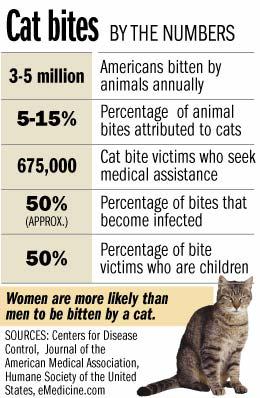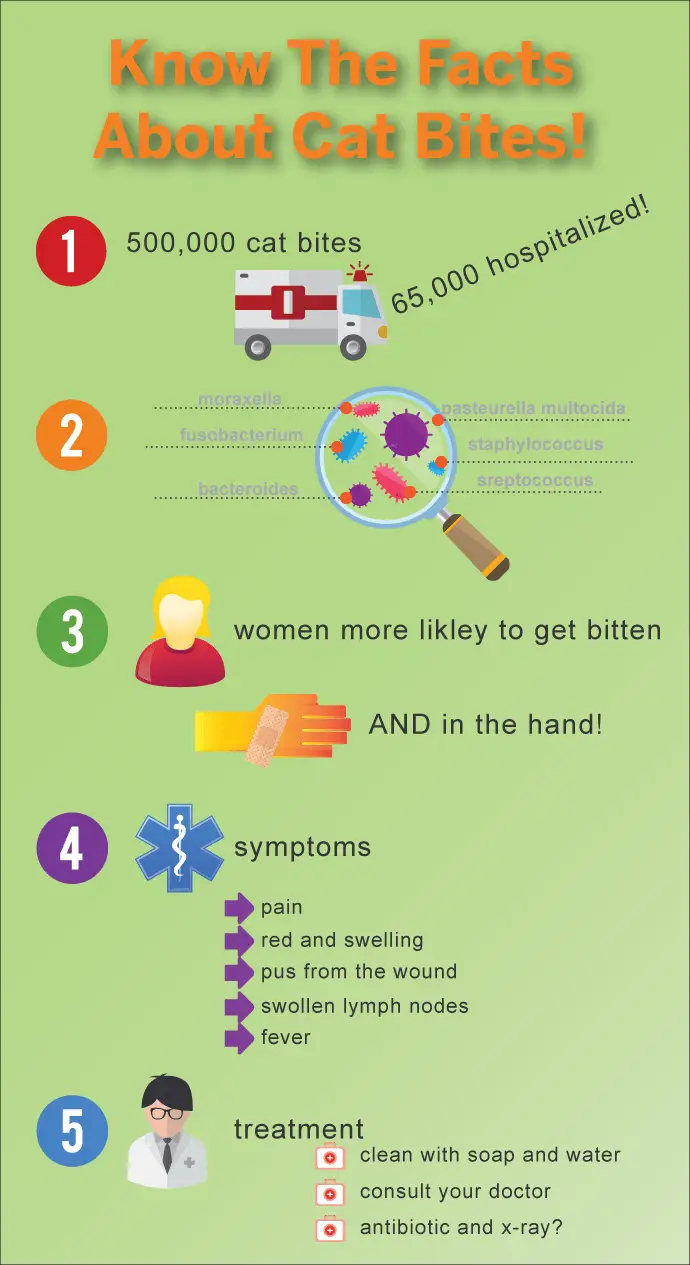Cat bites account for only 10 to 15 percent of animal bites treated in emergency rooms. The problem is that as many as 50 percent of these cat bites become infected and require medical care. Bites are almost always inflicted either by the victim’s own cat, or by a cat belonging to a friend.
The sheer numbers of bites are surprising:

So what is it about cats that make their bite wounds so prone to infection?
Although cats have no more germs in their mouths than dogs or people, researchers at the Mayo Clinic found that when cats bite, their sharp teeth make relatively deep puncture wounds and can inject hard-to-treat bacteria into the skin and joints, increasing the risk for serious infection.
When the bite is on the hand (and other research has shown that up to 85 percent of cat bites occur on the hand or wrist), the puncture can quite easily pierce a joint or the membrane around a tendon. These joints and tendons have closed spaces and are easy for bacteria to enter and spread.
A similar type of injury can also happen with cat scratches. Their sharp, curved nails can penetrate deep into the skin, and inject bacteria into the puncture wound.
If you are bitten (or scratched) by a cat, here’s what to do right away:
First Response Steps:
1. Clean the wound immediately with lots of soap and water, rubbing alcohol, or hydrogen peroxide.
2. Put pressure on the wound to stop the bleeding.
3. Hold the wound above your heart if the bite is on your hand or arm.
4. Place a clean bandage over the wound.
5. Assess the wound for signs of infection: unusual redness or swelling, increasing warmth in the area, red streaking, or fever. See a doctor if signs of infection develop.
6. Get a tetanus shot if your primary series is incomplete or if it has been more than five years since your last shot.
7. Determine the rabies vaccine status of the cat. The cat should be observed for 15 days to see if it develops signs of rabies if its vaccine status is uncertain. Rabies is a virus that can be fatal if a vaccine is not administered in time.
*Please note that this information is not intended as a substitute for professional medical advice or treatment.
Seek medical care if the wound is gaping, if bleeding does not stop within 15 minutes, or if you have specific medical conditions or concerns. *As noted earlier, this information is not intended as a substitute for professional medical advice or treatment.
If you are bitten, and the wound is deeper than just a small break in the skin, go to an Emergency room as soon as possible. Cats have sharp teeth and a bacteria in their mouths called Pasteurella. When they bite hard, their sharp teeth act almost like a needle puncture pushing the Pasteurella deep into the muscle. Because their teeth are also small, the wound may close over right away, trapping the bacteria in.
Pasteurella is an anaerobic bacteria – it grows in the absence of oxygen. The infection happens very quickly and can be very painful, even when properly treated.
An infected cat bite wound will be red, swollen and painful, and the infection can spread through the surrounding tissues, causing a condition called cellulitis, or through the blood to other areas of the body, causing blood poisoning (called septicemia). People who get an infection may suffer from fever and flu-like symptoms and, rarely, may die without proper medical treatment. Children, the elderly, and those that are ill are particularly vulnerable to developing severe infections if bitten by a cat. You may need an x-ray of the injured area to check whether there is a foreign body lodged in the wound, or damage to any bones.
Middle-aged women are reported to be the group most often bitten by cats, with most bites occurring on the hand. Young children are more likely to have their faces close to the cat, so are more likely to be bitten there. {infographic courtesy of catbiteinfection.com}

Seeking treatment immediately will save you a lot of pain. Many people who have bad bites and don’t seek treatment end up with throbbing pain, a fever, a bad infection, and eventually an IV, antibiotics and even a partial cast. Recovery after a severe bite to the hand can take many weeks, and intensive physiotherapy may even be needed as scar tissue can reduce joint mobility. Despite prompt, intensive treatment some patients will have life-long joint thickening and arthritis.
Cat bites need to be taken seriously and carefully evaluated by a doctor. If you are bitten it’s best to seek medical help as soon as possible.
********




Just listened to first 3 chapters of Cat Secrets audio – very helpful. Thank you. 🙂
My cat (Pickles – yes, he luvs them) only bites my brother – never me or my sisters. Not sure why.
WELL WITH FACT THAT UR BROTHER IS THE ONLY1 IS THERE A POSSIBILITY THAT HE IS MISTREATING THE CAT OR THERES SOMETHING ABOUT HIM THE CAT DONT LIKE???
HARD TO SAY BUT I WILL GO WITH THE CHOICES I NAMED TY
my nephews cat did that also only bit and scratched him not his mom or brothers. also my cat gave me ringworm once ages ago i guess some families are cat people some are not were the not.
Never mess with a cat bite – I let one go and it got really infected. The doc told me lots of serious cases of people who ignore cat bites. My advice – don’t.
I had a cat bite in my knuckle on the hand not fingers. I didn’t go to the hospital. I’ve been bitten before (cat rescue person here, not a hoarder lol) & have never had a problem. I went on the advise of someone in a store checkout. They asked me what had caused the stripes on my arm. I hadn’t paid attention to it I just knew I was in terrible pain.
when I walked up to registration the receptionist in the ER took me straight back to one of the full blown trauma rooms. I had waited too long & right there in front of me discussed amputation. I begged for other ideas. They finally (like within 5-8 min) decided to get me in surgery. I ended up in infectious disease intensive care where I stayed for 18 days. I had to have a second surgery 2 or 3 days after the first. After the hospital I had several weeks of IV antibiotics with a nurse coming to my house everyday.
Here’s a great joke of it all. I have cats, They wanted to know if I was giving them away….Of course I wasen’t….Then the topping…..2 days after I got home I got a call from someone whose kid had found 6 kittens, approximately 1 1/2 weeks old…total bottle babies. These little furballs gave me the will to press on with something great to live for>to raise them and find them great homes. ..I succeeded except 1. He went to 3 homes & everytime they returned him. He couldn’t handle any one but me. He’s a cuddly lovebug for me.
Sorry such an extra long message…. I was just taken back with the article. I was that article.
I know some young women who took in a cat from a homeless person. The cat attacked and bit the mother of one of these women. The mother soon had a terrible infection that was extremely painful, very swollen, and she was hospitalized for a few days to deal with the infection. She is home now but on antibiotics and slowly recovering.
The cat was quarantined for 15 days and does not have rabies. However, the mother wants her daughter and friends to get rid of the cat. They refuse. The cat bite was reported to the county, so if the cat bites someone else again, the three protectors should be liable for keeping a dangerous animal. I think they should give the cat to a shelter with a clear explanation of the situation and let them decide what to do, as professionals. I would not want to visit these people who are endangering others. What do you think should be done with the cat?
Tea tree oil is good to put on any kind of puncture wound
Don’t mess around with any cat bite that breaks the skin. My vet warned me about how infectious they are. Go see your doctor right away and get antibiotics. She had a patient who ended up in the hospital for a week on intravenous drugs because her infection went systemic.
Pasturella is very serious! I cannot stress this enough!! If you have puncture wounds, don’t bother with peroxide. Load it up with alcohol. It will probably be excruciating, but trust me, it will be a whole lot better than if you don’t. And then get to the ER or emergency clinic ASAP. I did peroxide and waited till the next day, by then I was in extreme pain and could not walk. I hobbled on crutches to the emergency clinic and they gave me the antibiotic shot that you have to sit there for a half an hour. This went on daily for three days. Finally I was sent to the hospital, where I was on intravenous antibiotics for four days. The pain was the worst I ever endured, two weeks before any relief, and I have has shingles, herniated disc, and broken ribs.
I’m sorry to hear about what happened. I definitely understand. I unfortunately had almost the worst experience someone can have. You are so right as well about the pain. My lucky part was mine was so bad after the surgery they kept me drugged for a few weeks and then pills for pain at home.
I have sent this in to vets to help people understand how serious this is.
I had a cat bite in my knuckle on the hand not fingers. I didn’t go to the hospital. I’ve been bitten before (cat rescue person here, not a hoarder lol) & have never had a problem. I went on the advise of someone in a store checkout. They asked me what had caused the stripes on my arm. I hadn’t paid attention to it I just knew I was in terrible pain.
when I walked up to registration the receptionist in the ER took me straight back to one of the full blown trauma rooms. I had waited too long & right there in front of me discussed amputation. I begged for other ideas. They finally (like within 5-8 min) decided to get me in surgery. I ended up in infectious disease intensive care where I stayed for 18 days. I had to have a second surgery 2 or 3 days after the first. After the hospital I had several weeks of IV antibiotics with a nurse coming to my house everyday.
Here’s a great joke of it all. I have cats, They wanted to know if I was giving them away….Of course I wasen’t….Then the topping…..2 days after I got home I got a call from someone whose kid had found 6 kittens, approximately 1 1/2 weeks old…total bottle babies. These little furballs gave me the will to press on with something great to live for>to raise them and find them great homes. ..I succeeded except 1. He went to 3 homes & everytime they returned him. He couldn’t handle any one but me. He’s a cuddly lovebug for me.
Sorry such an extra long message…. I was just taken back with the article. I was that article.
great suggestions on how to care for a cat bite ~ thanks!
yeah. I also have been bitten, attacked by dogs. Almost lost my left thumb when a stray yellow lab attacked me. Almost lost my head to a #225 great dane. and was assaulted by a #225 mastiff because his owner thought it was funny that his dog attacked me.
I have never been attacked by a kitty cat.
I hope you sued this person who thought it was funny his dog attached you. Homeowners’ Ins. should cover it.
id have to disagree about stopping the bleeding. i think you should let it bleed to get as much of the nasty stuff out of there so it doesn’t get infected. my brother once found a starving stray kitten and i fed it some cold cuts but it was so hungry it sank its teeth deep into my finger. lol not the kittys fault as it was starving but it hurt like hell!!! it never got infected but i was a lot younger then. we adopted him and he hung out with us in the yard and basement tripping me up as i was rebuilding a motor for my car. i taught him to climb up my body on my clothes but when he got older i realized it was a mistake lol. some days he would come running around the corner and jump up in the air and attach himself to my leg!!! ouch!!! lol as soon as anyone sat down he would be in their lap purring away. even some friends that “didnt like cats” loved him. he died of lukemia when he got older. i miss him still but hope to see him again when its my time. maybe when i die the first thing that will happen is a ghost kitty will attatch itself to my leg!!! LOL cheers!!!
I like the way you think Dave. When my time comes I expect to be met by many of my furry friends.
Almost lost my 90s-year-old to a cat bite from Pasteurella. It was just a play bite as her can was very sweet and had never bitten before, but within hours she was delusional, hallucinating, and had red streaks running up her leg. We were told we got her to ER in nick of time. She was hospitalized for more than a week.
I’ve had three cats since I was 10 and I’ve been bitten many, many times. The most I’ve ever done is wash the wound thoroughly with soap and water and use first-aid or anti-bacterial cream. It’s done the trick every time.
You and me both–alcohol is wonderful for keeping cat scratches from becoming sore afterwards. it stings when you splash it on, but it works. I wash bites and dab it on them, too–I think I’ve had so many bites by now that I am probably immune!
Prevention tip: when your cat grabs your hand/arm in his mouth to bite it, the instinct is to pull it away — bad move. The cat will bite harder, and pulling away will rip open your skin. The smart thing to do is to PUSH towards your cat, right into his mouth — he will then get scared and do his best to get your hand/arm out of his mouth! Can make the difference between a deep bite and a scratch.
But even if it is a small scratch, it must be treated.
Had a puncture cat bite once. Within minutes it was throbbing. Started IV drugs that day. 3 times a day for a week. Even after that, it still abscessed. They cut my finger open and put a drain in it for 2 weeks.
don’t know what folks are doing to get bitten. i have 2 cats, one is 15 and the other 16 and neither cat ever has bitten me. no scratches either! i just pay attention to the warning signs they give when something is annoying or frightening them and leave them alone. a minute later they’re back to normal and everyone is happy!
I play hard with my cat. Get major bites and scratches daily. She draws blood daily. Never had a problem. I let her think she wins.
The fires alarm went off in my bldg which freaked my cat out and she hid in the closet. I had to get her to put her in her carrier and as I reached in with the alarm blaring so loud, she freaked and bit me. There was no fire, thank God but my hand immediately turned red and got swollen. My aunt told me to go to urgent care immediately. Glad I did because it immediately got infected. I was given a tetanus shot and the doctor drew an ink ring around the swollen area and said if it spreads, go the the ER immediately. People have lost limbs because of this. So if you ever get bit, take it seriously.
My cat bit me a few years ago (I was just trying to pet him) between my index finger and the second finger (the one that you F lash when ur mad). It didn’t bother me then, no blood or anything but by the next morning, my three fingers and half my hand was swollen. Went to ER and this sadist dr. poked and probed the damn thing for almost an hour! I was screaming like a banshee! Had a couple of stitches put in and in a week the swelling went down. I still hate that cat but I still have him.
I WAS BITEN BY MY CAT . WAITED TO LONG TO GO TO THE DR. ENDED UP IN THE HOSPITAL WITH IV AND HEAVEY PAIN MEDS . FOR 2 WEEKS .
I never REALLY knew how serious a cat bite could be, until a bite to my ankle became infected. Oh, yes! PAINFUL! Morphine added to the IV for first 2 days in hospital. In hospital for 65 days, then had PIC line to return every day for additional IV antibiotics for 5 more days. Nurses all told me thst the majority of admissions for animal bites were for infections from cat bites; and, they had seen many cases of people needing amputations (hungers, toes, even hands and feet) to stop the infections.
Still love my cat, but will never, ever, be casual about cat bites, ever again.
And, since her bite landed me in the hospital, kitty is now known to have a dangerous bite, and will not be accepted for boarding at my vet’s office when I go on vacation.
in hospital for 5 days! (not 65!!)
DANG my fumble fingers!
I’m on the same page as you except I was in hospital a shorter time. I had a bite on the joint near the hand.
didn’t go to hospital & the next day the ER docs were considering amputation. Spent a few weeks in hospital and then had to continue the iv’s from home everyday. That was the index finger & it is now hard to use, it curls up.
If you get bitten – stop everything else you are doing, and IMMEDIATELY MAKE THE WOUND BLEED – squeeze it, smoosh it – do whatever you need to do to MAKE it bleed, to clear bacteria that were deposited by the cat’s teeth. Then, wash the wound vigorously with lots of soap and plenty of water; if you have peroxide available, finish the cleaning of the wound with a splash of peroxide.
Then, if redness and swelling develop do NOT DELAY in seeking medical help. If you develop the infection known as Cellulitis, from a cat bite, you will be lucky if it can be treated with oral antibiotics. If you are unlucky and the infection is drug resistant, you could end up in the hospital for many days on IV antibiotics.
Speaking from experience: I’ve had several bites that I cleaned immediately, and had no problems. There was one that began to look a bit red about an hour after that, so i scratched it open, made it bleed, and then did a thorough washing again – and it was ok after that.
But then there was a bite to my ankle, and I waited about 10 minutes before I made that one bleed and cleaned it. It developed a red, swelling area within 4 hours; I got oral antibiotics that evening (about 7 hours after the bite) – and by the next morning they were clearly not working. Got stronger oral antibiotics, and by that evening it was clear those were not working either. In less than 48 hours after the bite, I was in the hospital, on IV antibiotics, to battle cellulitis that was almost up to my knee. My calf and foot were reddened and painfully swollen – skin so tight it looked like it was about to split open, and so painful , so painful! Could NOT put ANY weight on it – needed a walker so I could hop on the other foot to get to the bathroom.
Note for some commenters smugly noting that their cats never bite (and that’s the entire content of what they have posted): Yes, I’ve also had cats who never, never bit anyone. But not all cats are the same, and it takes some cats a while to learn to NOT bite hard in play (especially cats without other kitty playmates to teach them that biting isn’t nice).
I agree with Dave. Let it bleed profusely. If an artery is pumping stop it and hold pressure for 5 whole minutes after letting it bleed for a few minutes. Clean with peroxide to let the bacteria bubble out of the wound. Keep it open, not covered so air can get to it. Bacteria grows in the dark, moist closed hole. P>S> I work in the medical field.
I was bitten by a friendly cat who just got tired of being petted. His long sharp teeth pierced some nerves in my arm. Years later that spot occasionally hurts. Also was bitten trying to rescue a tiny feral kitten. Those teeth sank all the way to the bone of my finger. Luckily no infections.
When my Gina was suffering from hyperthyroidism, her entire personality changed. Always sweet and loving, one day without provocation, she sank her fangs into the ring finger on my left hand. To this day, part of that finger has no feeling in it. Luckily, it did not get infected. I had never owned a pair of “animal handling” gloves, but now I do….elbow length ones, because I never want to feel the horrific pain I felt the day I was bitten.
I have several feral colonies and have worked/volunteered for a non profit org. who takes care of all medical needs. Doing TNR I had an appx. 12 week old kitten in the trap. To make a long story short, this little kitty sank her tooth into the joint (knuckle) of my index finger. The puncture was so small you could hardly see it. I squeezed it, cleaned it with alcohol and peroxide and didn’t give it a second thought. 10 hours later (3AM) my finger was the size of a large dill pickle, purple, throbbing in pain! It was excruciating! Went to urgent care and they shot me up with mega antibiotics, tetanus shot, did x-rays and sent me home with oral antibiotics. I was back in the urgent care every day for the next 4 days! It was not getting better and the pain was unbearable. Finally, a Dr. @ urgent care happened to be a hand surgeon and asked me why I hadn’t been to him the day this happened. I had no answer, I told him to ask the previous 5 Dr.’s who saw me. He told me to wait until closing (about 1 hr) and he told my ride to follow him to his office. He did hand surgery on my finger and palm. He advised me that I was very close to losing my entire hand! Dr. Hay saved my hand. I still am very active in TNR and have 3 feral colonies in which I have trapped all, had their surgeries, shots and micro-chipped. The moral of this writing is to tell you what Dr. Hay told me… If you are bitten by a cat which breaks the skin IMMEDIATELY get yourself to a DR! A cat bite can be worse than a snake, rat, dog etc.
same thing happened to my aunt but not doing TNR with ferals. I feel for you and glad you came out of it OK. my aunt still has the scars.
I’ve been bitten by a cat more times than I can shake a stick at. My Bailey often loves to do that, and I pull my hand away; I just love teasing him at times. Once I had this one cat whose collar got in his mouth; he looked like a horse with a bit in its mouth. Leroy was going crazy, and I am trying to get the collar out of his mouth. Leroy tore my hands up and part of my face up; he stuck a claw into my finger and yanked it out; I had an infection in that finger. The infection went away because I used peroxide, and I did not have to see a doctor about it. Leroy and I were the best of buddies in all the years I had him just like Bailey and I are.
My aunt, a long time cat lover and cat owner, was bitten by a cat a couple of years ago while she and my mother were out of town at a funeral for an old friend. She followed all the guidelines for treating a bite from an animal that she didn’t know or own. She washed it, disinfected it treated it with antibiotic ointment and bandaged it. It didn’t take long for her to become ill. In fact in the coming 24 hours she became extremely ill. By the time she and my mother got home the next day my aunt was extremely ill. My mom and dad took her directly to the ER which was a good thing. She ended up spending the next week in the hospital in the ICU. She very nearly died. She was in an out of the hospital for the next two weeks having stitches from a lancing removed and multiple antibiotic treatments. I am over 50 years old and this is the first time in my entire life I have ever seen anything like this and I too have had cats all my life. Do not take chances if an animal, even a cat bites you. You never know how well the owner takes care of it, what the animal has been doing or eating, and worse yet it could be something you are allergic to which could make matters even more deadly for you.
Both I and a friend of mine have made trips to the ER to have infected cat bites treated. My advice is if the bite looks at all infected, it probably is and you should see a doctor.
My friend and I were both bitten when we were holding on to male cats who had given us plenty of warning (snarls, hisses) that they were angry and wanted us to let them go. I’m not sure I wouldn’t have done the same thing in their place.
My cat bites me all the time! No harm intended and I’m still here!
My indoor cat bit and scratched me, a month ago. It didn’t become infected because I use a popular pet teeth cleaning gel on her daily and I take Collagen Supplements for my joints, which caused it to heal quickly. I also periodically put Colloidal Silver in my pet’s water bowl to keep the bacteria down in their mouths.
First night of my Florida vacation I went to get my suitcase from the car and I heard meowing. There was a 6 week old kitten hiding in the bushes outside the hotel. I ran inside to get some help from the staff, I needed a box, a blanket and some help catching him. Luckily there was a cat lover on staff and out we went to go get him. It took a while to catch him as he was feral and scared of us. Finally I got hold of him and he started chomping down on my finger, I didn’t let go we had him,in the box he went. The staff person was taking him home, he was going to be her new kitty, I now had to deal with the bites and my bleeding fingers. The hotel gave me some basic first aid, peroxide, neosporin and band-aids. Rabies? No way that kitten had any rabies shot and I certainly couldn’t hang on to it for 15 days I was only in Florida for 5 days. I knew I was going to need to get rabies shots, but from where and when. I called the Health dept back in my home state and they told me to go to the Health Dept in Florida. That wasn’t going to happen, where is the health dept, I have no car. So we continued to enjoy our vacation. When I got home on Sunday I called the health dept again, they told me it was ok and that I had 5 days to get the shots. I then said told them it happened on Wednesday and she said get to the hospital. So I got my rabies shots, they were no big deal a series of them over the next few weeks. That kitten was safe and to me that is all that mattered. The bonus, I had my rabies shots, I was good to go if anything else bit me.
Cats can be nasty…especially ferel cats and you can get cat scratch fever from them. They carry all kinds of diseases better off to leave them alone and not feed them. Let them find their own food.